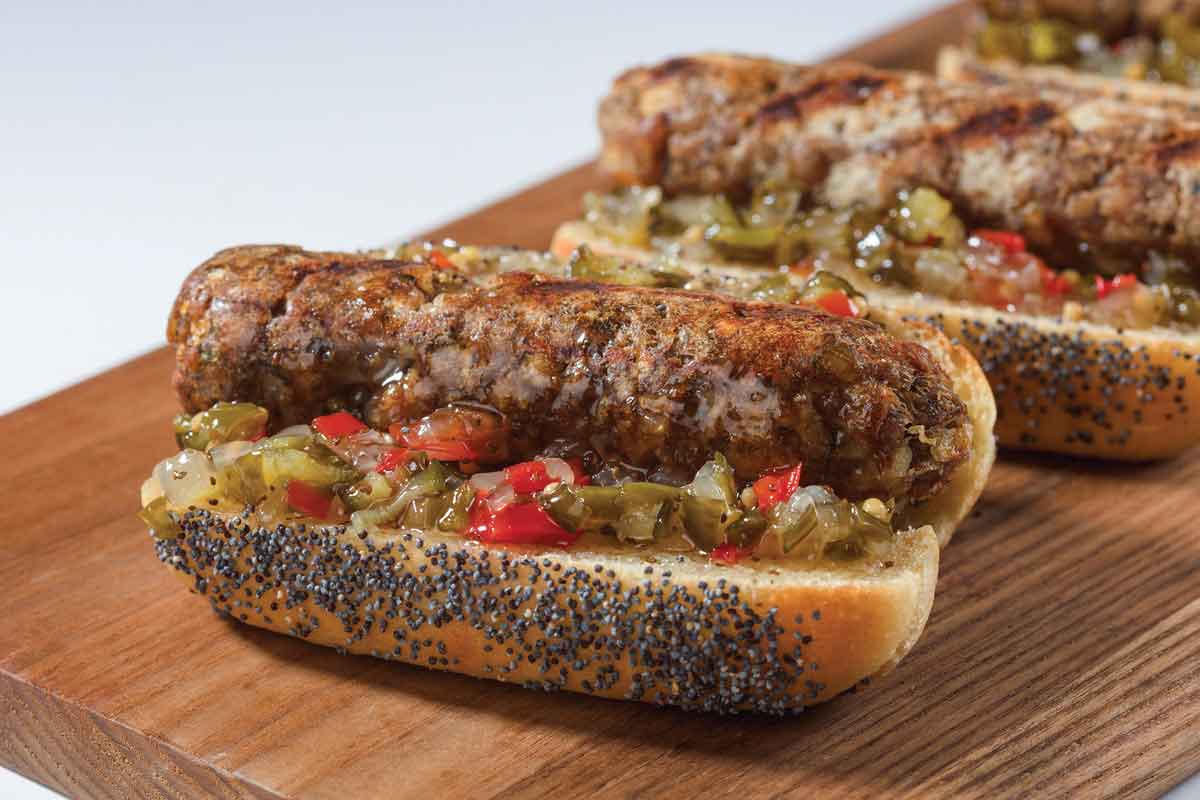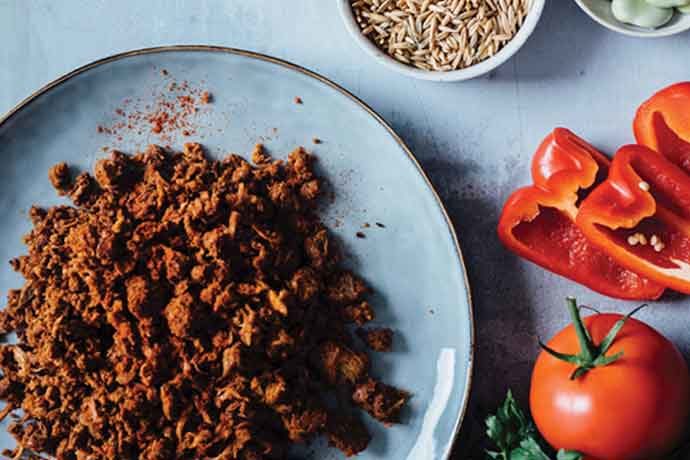One-third of US consumers indicated they used plant-based meats this past year, according to the Natural Marketing Institute, Harleysville, Pa. The younger the consumer, the more frequent the consumption. Burger and ground formats are the most popular and are consumed by 62% of plant-based meat users. Chicken-type analogs are the second-most common format and are consumed by nearly two out of five (39%) plant-based meat users. This is followed by sausage (33%), bacon-style (24%), hot dogs (23%), turkey (22%) and lunchmeat (15%). Some of this use may be a result of availability and variety.
“Ground and burger-style products are typically the easiest to replicate as the format is already using a reduced particle size,” said Zachary Reed, senior associate-meat applications, Ingredion Inc., Westchester, Ill. “Whole muscle, on the other hand, is made up of muscle fibers that give striation to the product. They are more linear proteins, where many plant proteins are globular, and this poses a challenge to getting the right look and feel to the product.”
There are many ingredients available to developers of meat and poultry alternatives to assist with developing the correct texture, flavor, color and cooking experience. Brands have been criticized for their “franken-food” list of chemical-sounding ingredients, so most new players entering the category are leaning toward cleaner-label ingredients that consumers recognize and, in general, as few ingredients as possible.
When developing meat and poultry alternatives, identify desirable product attributes up front, as well as nutritional and ingredient compositions. Positioning claims, such as all-natural, organic and non-GMO will assist with narrowing in on ingredient options. The innovation team should agree if the alternative is meant to emulate an animal-based product or if it’s a one-of-a-kind concept.
“Finding new, more label-friendly formulations might well be the category’s biggest challenge,” said Melissa Machen, senior technical services specialist – plant protein, Cargill, Minneapolis.

Toolbox of ingredients
The first step is to determine the source of protein. Many alternatives in the market rely on more than one, as each plant brings unique properties to the formulation. While not necessary, alternatives should strive for delivering a complete protein composition, which means that the finished product contains all the essential amino acids in the right proportion for optimal body performance. Animal proteins are good sources of complete proteins, while most plant proteins are limited on specific amino acids.
“Textured soy protein is a functional and nutritionally complete protein based on its PDCAAS (Protein Digestibility Corrected Amino Acid Score),” Machen said. “Many other protein sources, such as beans, rice protein and potato protein are considered limiting proteins; however, they can be blended with complementary proteins to create a complete protein source.”
For cost optimization, textured soy protein is one of the most economical and versatile plant proteins. It comes in numerous shapes, sizes and even colors and enables formulators to mimic meat’s natural fibers with a sensible cost-in-use.
“Many emerging plant proteins yield unsatisfactory texture when included in formulations in a powder form, but extruded ingredients can provide a better bite and improved support for the structural integrity of the formulation,” said Ross Wyatt, global manager of meat science and flexitarian solutions for Archer Daniels Midland (ADM), Chicago.
Extrusion assists with the development of a fibrous meat-like texture. The plant protein ingredient system needs to be at least 50% of the dry base.
“Hydrocolloids and texturizing ingredients can be added to facilitate the processing of the protein mix,” said Julie Prost, pilot plant manager and process engineer, Clextral USA, Tampa, Fla. “Fat and vegetable fibers can also be added to adjust the texture, and flavors added to mask some off-flavors of the vegetable proteins.”
Wyatt agreed that texturized proteins are generally the “work horse” ingredients of meat alternatives because they play a major role in finished product texture and nutritional makeup. “Although texturized soy, wheat and pea proteins are the primary source of texture, functional protein powders can be added to boost the protein content in a formulation,” he said. “All ingredients in a meat alternative must work together to provide the desired functionality, nutrition profile and eating experience.”
Pea protein has been gaining traction in the alternative meat space. Suppliers offer many varied formats.
“With functional attributes similar to soy, it’s a good choice for brands aiming to keep major allergens off product labels,” Machen said. “Plus, it has the added attraction of a more neutral flavor profile than soy.”
Roquette America Inc., Geneva, Ill., offers pea protein isolate with 85% protein and textured pea protein. Textured pea protein comes in several grades to help mimic the sensory properties of various alternatives.
“Textured pea protein with 0.5- to 1-cm particles can be ground to desired particle size after hydration for meat-free burgers, sausage patties, sausages, chicken nuggets, meat balls, taco meat and more,” said Chandani Perera, principal scientist at Roquette.
A smaller particle size can be used in the same applications without further grinding. Roquette offers another grade with a softer bite, which is good for pulled pork and meat-free fillings for meat pies, samosas and empanadas.
For those with the capabilities of high-moisture extrusion, pea protein isolate can be used to create alternatives with muscle meat texture, according to Machen. This includes chicken- and beef-type strips typically made with a single piece of meat that have long fibers.
Ingredion has protein concentrates and isolates from pea, lentil and broad beans. These proteins are typically used to add protein content from a nutritional standpoint. Additionally, they will provide some water-binding capability along with texture.

To replicate some of meat’s textural properties, formulators will typically include hydrocolloids with the plant proteins. These ingredients bind moisture and assist with keeping the alternative juicy and tender.
Carrageenan, for example, delivers a firm, sliceable structure and eating texture. Starches and fibers may be used in the binder system to create the optimal balance between a firm bite and juiciness, according to Machen. Cargill offers functional, native starches that can help produce a firm, meaty texture due to their water-binding capabilities, yet still meet consumers’ label expectations.
“Fats and oils have critical roles in meat alternative formulations, too,” said Jamie Mavec, marketing manager, Cargill. “Fat sources are used for food fortification or adding essential nutrients, creating succulence and replicating the ‘juicy’ experience associated with animal proteins, as well as adding to the texture. Oil sources are included to add moisture and lubricity to help simulate the mouthfeel of animal proteins.”
Common plant-based fats include those high in saturated fatty acids, such as coconut oil, palm kernel oil and palm oil. They are more solid in structure and less prone to oxidation.
“Plant-based oil sources include high oleic and mid oleic sunflower oil, which has good oxidative stability; canola oil, which is low in saturated fat, but high in monounsaturated fat; soybean oil; cottonseed oil and peanut oil,” Mavec said.
Wyatt said, “Bite and chew are essential components of texture and mouthfeel. The amount, type and release of fat are important factors for achieving the desired sizzle in the pan or juiciness when eating.”
Many suppliers take a systems approach, blending the dry ingredients together. Proper hydration is key.
“Ingredion offers an array of starches to help with water binding and creating a gel to help with texture,” Reed said. “Some of our pregelatinized starches can also help with fatty mouthfeel, while others help with emulsion stability. This can be very important in applications such as hot dogs.”
Florian Bark, product manager, Hydrosol, Ahrensburg, Germany, said, “We’ve developed a modular system that can be used to make a wide range of alternative meat products, including a new generation of plant-based nuggets. It’s made of wheat and pea protein, which gives the nuggets a long fiber structure, pleasing bite and light color typical of chicken.
“Our modular system requires no special processing techniques,” Bark said. “With it, products can be made on standard production lines, just like those used in regular meat and sausage production.”
Wigberto Núñez, group manager, meal solutions, DuPont Nutrition & Biosciences, New Century, Kan., said, “Key functional ingredients used in meat and poultry alternative formulations need proper dispersion and hydration to achieve optimum functionality. Formulation changes and process adjustments that impact hydration time, order of addition of ingredients and mash temperature are very important when troubleshooting formulations to optimize the performance of functional ingredients.”
The flavor factor is an important consideration, namely that savory taste of meat known as umami. Yeast extracts, natural flavors and even mushrooms are proving to be helpful. Color, too, is a consideration.
“Plant proteins have specific, often unpleasant flavor characteristics and these off-notes need to be addressed with masking solutions in addition to flavors,” said Sylvain Jouet, global product manager, plant-based proteins, Givaudan, Switzerland. “Protein also tends to trap flavor molecules in its structure and not all flavor components are trapped in the same way, creating profile imbalances.”
Balance is key for flavor optimization. It is important to address the whole eating experience.
“From the right meaty color and smell during cooking, to the authentic texture, taste and aroma experienced during consumption, formulators need to address all sensory characteristics,” Jouet said. “Our latest innovation is a breakthrough fat encapsulation technology that can help reduce up to 75% of the fat content and 30% of the calories in meat substitutes compared to current market products, while maintaining a delicious, juicy, succulent taste.”
He emphasized the need to not only include natural vegan flavors suggestive of beef, chicken and pork, but also to include culinary notes based on common cooking techniques. This includes smoking and grilling flavor solutions to add authentic meaty taste.
“We are also able to create an authentic-looking meaty color for these products with a range of high performance, clean-label coloring solutions,” Jouet said. “A new color obtained from beetroot and other natural extracts can be used to achieve an authentic fresh meat-like red color in meat substitutes, in particular in raw and cooked patties.
“In meat-free burger patties, the blends undergo a color transformation during the cooking phase, turning a brown color that closely mimics grilled meat. Using different formulations to accommodate a wide range of applications and regulatory requirements, our application team is ready to support customers in achieving the right colors for these very complex food matrices.”



